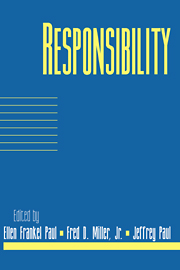Book contents
- Frontmatter
- Contents
- Introduction
- Acknowledgments
- Contributors
- Causation and Responsibility
- Negligence
- Responsibility and Consent: The Libertarian's Problems with Freedom of Contract
- The Irrelevance of Responsibility
- On Responsibility in Science and Law
- Responsibility and the Abuse Excuse
- Why Citizens Should Vote: A Causal Responsibility Approach
- Institutionally Divided Moral Responsibility
- Fate, Fatalism, and Agency in Stoicism
- Ultimate Responsibility and Dumb Luck
- Taking Responsibility for Our Emotions
- Index
Negligence
Published online by Cambridge University Press: 06 January 2010
- Frontmatter
- Contents
- Introduction
- Acknowledgments
- Contributors
- Causation and Responsibility
- Negligence
- Responsibility and Consent: The Libertarian's Problems with Freedom of Contract
- The Irrelevance of Responsibility
- On Responsibility in Science and Law
- Responsibility and the Abuse Excuse
- Why Citizens Should Vote: A Causal Responsibility Approach
- Institutionally Divided Moral Responsibility
- Fate, Fatalism, and Agency in Stoicism
- Ultimate Responsibility and Dumb Luck
- Taking Responsibility for Our Emotions
- Index
Summary
introduction
Faced with the choice between creating a risk of harm and taking a precaution against that risk, should I take the precaution? Does the proper analysis of this trade-off require a maximizing, utilitarian approach? If not, how does one properly analyze the trade-off?
These questions are important, for we often are uncertain about the effects of our actions. Accordingly, we often must consider whether our actions create an unreasonable risk of injury–that is, whether our actions are negligent.
Consider two examples:
(1) The (mythical) Ford Pinto: The manufacturer of an automobile discovers that strengthening the fuel tank on 12.5 million existing vehicles would cost $11 per vehicle and would prevent 180 burn deaths, 180 serious burn injuries, and 2,100 burned vehicles. Calculating a unit cost of $200,000 per death, $67,000 per injury, and $700 per burned vehicle, the manufacturer concludes that the total cost of preventing the injuries is $137.5 million, while the accident losses that the precaution would prevent amount to $49.5 million. Accordingly, the manufacturer chooses not to take the precaution.
(2) Two speeding drivers: Amy drives at high speed to the hospital to obtain medical care for her child, whom she reasonably believes to be in need of emergency medical care. Beatrice drives at high speed to a critical business meeting; she reasonably believes that if she misses the meeting, there will be a significant delay in implementing a health delivery system, a delay that might cost several lives.
- Type
- Chapter
- Information
- Responsibility , pp. 52 - 93Publisher: Cambridge University PressPrint publication year: 1999
- 2
- Cited by

